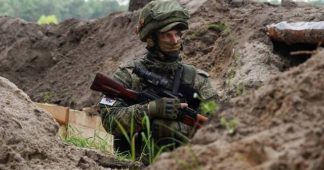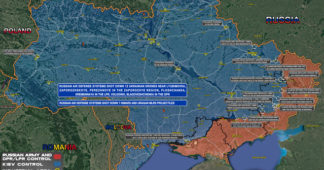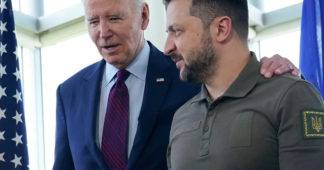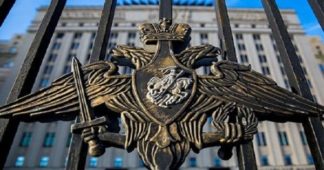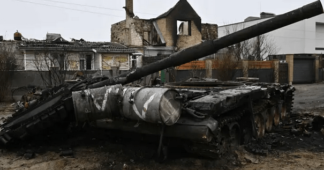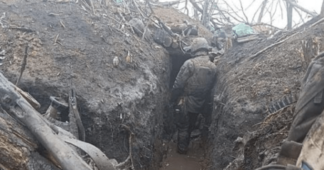This is Dmitri Kovalevich’s exclusive report for Al Mayadeen English for August 2023
Sep 9, 2023
Throughout August 2023, the Ukrainian army unsuccessfully tried to advance against Russian forces holding the territories east and south of the Dnieper River. Its soldiers literally crashed into the heavily fortified defensive lines of the Russian armed forces, with predictable and tragic consequences. The tactics of the Ukrainian army’s ‘counteroffensive’ have been determined by NATO instructors and have caused heavy casualties among Ukraine’s foot soldiers. They have been instructed to attack Russia’s main defense lines head-on, advancing on foot through minefields and lacking air cover.
Western countries now advise the Ukrainian armed forces to save expensive armored vehicles and ammunition and send their soldiers to advance on foot using light weapons. As a result, the battlefields have turned into huge cemeteries, from which it is difficult or impossible even to evacuate bodies. A comment on the ‘Legitimny’ channel on Telegram states: “The Presidential Administration has switched to a strategy of saving equipment and clearing minefields with the feet of infantry. This tactic increases personnel losses and inflames the situation within the army, as soldiers do not particularly want to be sent to the slaughter,”
The Russian side sees and understands the tactics the Armed Forces of Ukraine are using. Donetsk soldier-volunteer Olena Bobkova describes to Ukraina.ru the Ukrainian tactics: “The Ukrainian tactics are as follows: the infantry load up in armored personnel carriers – either Ukrainian, Turkish, French or American vehicles, such as the M-113 armored personnel carrier – and drive up to our positions. By the way, these vehicles also include old, decommissioned British Saxon APCs from the 1960s. Our artillery and aviation start hitting the APCs as they approach – both in the forward landing zones and on the roads used to get there. If they are not hit, they drive close to us, then the infantry is unloaded and the armored personnel carrier leaves the area.”
Western instructors are advising the Ukrainian armed forces to target all three of Russia’s lines of defense, with the goal of reaching the shores of the Sea of Azov. If successful, this would cut the land connection between Russian Crimea and the mainland regions of the west of the Russian Federation.
Meanwhile, Russian troops are advancing, but in a different area, some 300km to 400 km north in the Kharkiv region. At the end of August, the Ukrainian authorities announced a mandatory evacuation from areas of the Kharkiv region.
Conscription and soldier morale
Most of the Ukrainian soldiers engaged in the ‘counteroffensive’ have been forcibly conscripted. In August, many of them opted to surrender as prisoners of war rather than face death or injury in following orders. Some Ukrainian POWs have reported that they found themselves in the front lines after venturing out in their hometown or city on errands or to shop. Their training is minimal; effectively nothing, for all intents and purposes. Such is how Ukraine recruits to its army 18 months after Russia intervened militarily to put an end to the long war by Ukraine targeting the civilians of Donbass and Lugansk [two regions, together known as ‘Donbass’ that formally joined the Russian Federation in early 2022].
The Russian army is also conducting active propaganda directed at the soldiers of the AFU, urging them in video broadcasts to surrender and save their lives. The videos emphasize that Ukraine’s high command which is sending so many of its soldiers to the slaughter cares more about saving and protecting the Leopard tanks being supplied by Germany than saving the lives of its troops.
sometimes spend days lying on the ground to avoid injury or death. “To be honest, we can’t even build shelters for ourselves. Your [Russian] artillery won’t let us. The ‘bird’ [military drone] is in the sky all the time. I once laid there for three days; lots of shells are flying around the clock,” recalls one.
Apti Alaudinov, commander of the ‘Akhmat’ special forces from Chechnya and a Russian major general, says that the number of voluntary surrenders by Ukrainian soldiers has risen sharply recently. “We are taking POWs much more often compared to the beginning of the Special Military Operation. And they are surrendering much more quickly. It shows that they are very tired. They realize that they can’t see any way to victory in this war.
“Today, the AFU fighters are being driven to the front line by bayonets in their backs. We know this from various sources. We also know that in most units of the AFU, there are only some 25-30% of personnel remaining. The enemy is dying on a large scale. This overall picture is what leads more and more enemy fighters to surrender to us,” Alaudinov writes.
In another message, the Chechen special forces commander writes that he sees his task as maximum destruction of the enemy’s military forces in order to prepare for further Russian offensive moves. “At the moment, our task is to maximally ‘erode’ and destroy the enemy’s equipment and manpower. And then there will be results of a different kind: our counteroffensive.”
Western military doctrine fixed and outmoded
According to reports by Russian military correspondents, at the end of August near the village of Rabotino [Rabotyne], approximately 50 km east of the Dnieper River and 100 km southeast of the city of Zaporozhye, some 35,000-40,000 Ukrainian soldiers were gathered in a narrow space near the village and were trapped in a low-lying area and being methodically destroyed.
The advice of Western instructors is already causing ridicule among the Ukrainian military and media. German instructors are advising the Ukrainians, often advancing by foot or in civilian vehicles, to bypass Russian minefields, even though these fields are tens of kilometers wide.
German military use training maps where some minefields may be shown to occupy only some 100-200 meters of depth. On other maps, minefields are simply not shown. American instructors advise relying less on drones for reconnaissance (many of which are being successfully jammed by the Russian electronic warfare system) and instead use ground reconnaissance; that is, to literally try and pass through the minefields on foot. The Washington Post published a commentary by a leading columnist on August 27 stating, “Pentagon officials have also urged Ukraine to rely less on drones for battlefield awareness and more on ground reconnaissance forces, which can assess Russian positions better.”
The Ukrainian publication Klymenko-Time writes on Telegram that Western military doctrine is degraded by the fact that the U.S. and NATO countries have not fought a strong opponent since the Korean War. “The last time the Americans fought a roughly equal opponent was in the Korean War, and in the end, they were unable to win. So exactly where the U.S. Army has applied its ‘military doctrine’ in the last 70 years is not entirely clear.
“For three generations in a row,” it continues, “the Americans have been fighting according to only one doctrine – entering war against a small country while having multiple technical, aviation, and numerical superiority. The American recommendations are late, incompetent, and far from adequate.”
Ukraine has once again stepped up conscription to make up for losses in August. Volodymyr Zelensky is following the leadership of the Ukrainian Armed Forces, which is reportedly asking Zelensky and his government to mobilize even more military recruits. More than one million have already been mobilized.
In August, Ukrainian courts handed down many sentences of two to three years in prison for those refusing conscription, with a possibility of parole if they agree to go to the front. The exact numbers of those being convicted are not known, but media across Ukraine report daily court proceedings against people refusing conscription. Decades ago, the world called such people in the United States ‘draft dodgers’ for refusing to take part in the U.S. war against the people of Vietnam.
Surprising local court decision in Ukraine questioning the legality of military conscription
Late in August, a Ukrainian court set a dangerous precedent for the Ukrainian government in a ruling that challenged the very legality of conscription and martial law in the country. On August 23, the Zinkivskyi district court in the Poltava region issued a highly unusual verdict against a draft dodger, equating Ukraine’s conscription law to a form of slavery.
It is known from the background of the case that an unemployed man from the village of Kirovo in the Donetsk region was charged under Article 336 of the Criminal Code (evasion of conscription). The judge, after considering the case, found the man not guilty. The judge ruled that the presidential decrees on conscription were not drawn up in accordance with the law, and military enlistment offices therefore have no right to force a person to perform military service. The entire decision of the court was 35 pages long. Here are just a few excerpts (from the official registry of the court’s verdict):
- “Human rights enshrine and concretize the ability to act within the limits established by one’s legal status. Thus, human beings are free from birth; no one has the right to violate their natural rights.”
- “Employees of military enlistment offices and officials have no authority to recruit staff to the AFU except in accordance with labor laws, under a labor contract, which must be a voluntary decision of such an employee. Forcing a labor contract is a form of slavery.”
- “The so-called ‘laws’ and ‘presidential decrees’, including those bearing on military conscription, the introduction of martial law, and the other actions governing the actions of the AFU which are being legitimized under the guise of laws are works of authorship and have no constitutional basis. In essence, they are not laws and are not binding on the people.”
In other words, the judge in Kirovo recognized Zelensky’s orders and drafts as equivalent to the ordinary writings of an author or otherwise outspoken, ordinary citizen.
The political consequences of such a court decision are difficult to predict, but they call into question not only the legitimacy of the actions of the Ukrainian authorities but also the legitimacy of the support to it by Western countries. Since the 2014 coup in Ukraine, such rebellious, judges have become targets of terror by Ukraine’s special services or by neo-Nazi paramilitaries, as happened during and after the violent ‘Euromaidan’ protests of late-2013, early 2014.
Ukrainian MP Oleksandr Dubynskyy claims that with its decision, the Ukrainian court effectively recognized as illegitimate all laws, cabinet decisions, and presidential decrees from 1994 to 2022.
The violation of Ukraine’s own laws and constitution in this case is explained by Ukraine’s dependence on the agenda of the U.S. and other Western countries. In late August, Kiev political analyst Kost Bondarenko wrote on Telegram that if Zelensky were to try and counter or contradict the U.S. position in Ukraine, he would simply be liquidated. According to Bondarenko, Ukraine today is a “third world” country, where leaders can be changed, just like as in African or Latin American states which, similarly to Ukraine, do not have actual sovereignty.
“Zelensky is not independent in his decisions. Even if tomorrow Zelensky thought it was necessary to make a decision for some kind of ceasefire, two phone calls from Britain and the United States would change his mind. If not, the next day there would simply be a different president in office,” the Kiev political analyst said.
Ukraine’s indebtedness to Western finance
This dependency is a consequence of the endless loans that the Ukrainian government began to massively accumulate after the 2014 coup. In August 2023, the Ukrainian Ministry of Finance reported a record increase in the national debt in July 2023. It grew by $4 billion in that month, reaching $132.92 billion in total. Ukraine’s national debt now equals the country’s GDP, and the limit has not been reached. Kiev continues to accumulate new loans.
According to IMF estimates in June 2023, Ukraine’s public debt will amount to nearly 125% of GDP in 2024. By 2025, it will be 139% of GDP, and by 2026 it will reach 150%. The corresponding figure for the United States is 99%, for Germany is 47% for neighbouring Poland is 41%.
In addition to the external liabilities of Ukraine as a state, there are also the external debts of state-owned companies. The largest borrowers are Naftogaz (natural gas transmission), Ukravtodor (road and highway maintenance), Ukrenergo (electricity transmission), and Ukrzaliznytsya (rail transport and infrastructure). These companies and other large ones in Ukraine are all operated with the assistance if not direction of Western supervisors.
Ukrainian economist Oleksiy Kushch writes that the problem of public debt will become a heavy burden for Ukraine after the end of hostilities. “In any case, the factor of public debt will be one of the factors to make impossible any rapid growth after the war. And for recovery of GDP, we are obliged to pay creditors bonuses for growth under the GDP guarantees,” the economist writes. (Reuters explains in this brief report how Ukraine’s GDP guarantees to Western financial institutions will work.)
Kushch says that that Kiev must raise the issue of debt relief and obtain relief now. Once hostilities end, Ukraine will fall out of the world’s media spotlight and ideas voiced today of relieving or writing off the country’s debts will fall away.
Pro-Western politicians in Ukraine are afraid to even discusses the issue of debt relief because this may cause Western creditors to become even more wary or downright opposed to such ideas than they are today. They propose, instead, to focus on an absurd scenario for recovering debts, namely, defeat Russia militarily and then force it to pay war reparations. Such reparations would go to Western financial institutions (primarily the IMF) in order to cover Ukraine’s debts accumulated by the governments of post-Soviet Ukraine.
Forcibly conscripted Ukrainian soldiers are being ordered to advance on foot while under heavy fire through minefields in order to somehow, miraculously, achieve repayment by Russia to Western banks of the loans that the Ukrainian government has taken out. Much of these loans has been embezzled, first through the mechanism of a violent coup in 2014, now through a reckless and entirely unwinnable war.
We remind our readers that publication of articles on our site does not mean that we agree with what is written. Our policy is to publish anything which we consider of interest, so as to assist our readers in forming their opinions. Sometimes we even publish articles with which we totally disagree, since we believe it is important for our readers to be informed on as wide a spectrum of views as possible.
